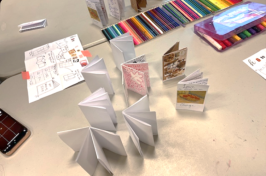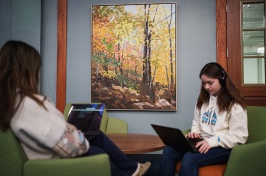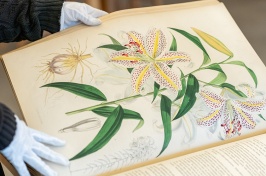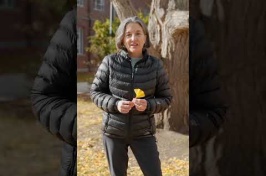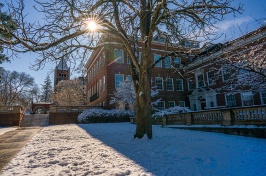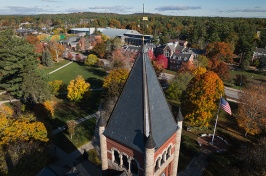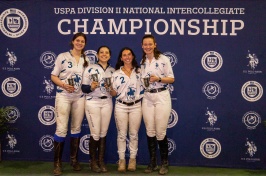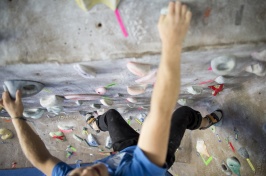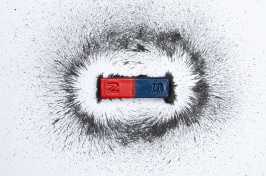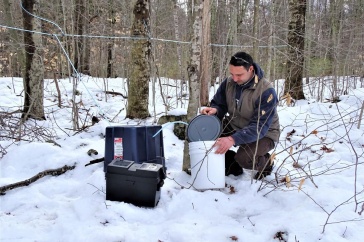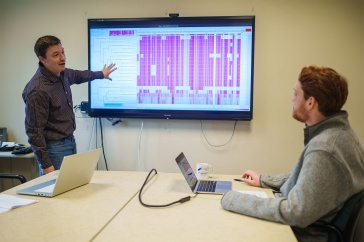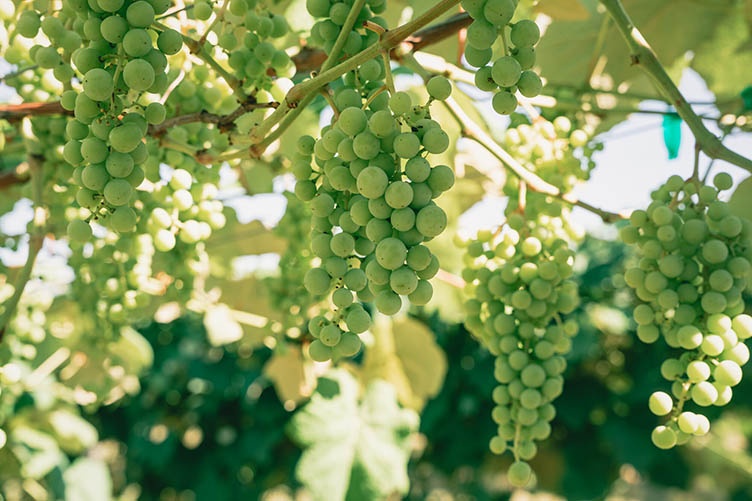
Healthy green grape bunches growing at the Woodman Horticultural Research Farm.
If you live in northern New England, the seedless table grapes in your supermarket traveled a long way to reach the produce section. But after seven years of study, University of New Hampshire (UNH) researchers with the New Hampshire Agricultural Experiment Station (NHAES) say that locally grown grapes may soon provide more options for Granite State shoppers. Their findings, published in HortScience, show that choosing the right variety and using strategic vineyard management are crucial for growing table grapes in northern climates, but the production performance of grape varieties such as Mars, Canadice and Lakemont offer potential for a commercial seedless table grape industry in New Hampshire and New England.
“There are several seedless table grape varieties that are well adapted to our region,” says Station scientist Becky Sideman, professor of agriculture, nutrition and food systems at the UNH College of Life Sciences and Agriculture. “These varieties bring delicious and unique flavors to consumers, and they expand the options for local producers.”

Grapes grown in warmer climates like California and abroad dominate the year-round market. Vitis viniferagrapes, which include nearly all of the well-known wine and table grape varieties, thrive in relatively warm and dry conditions and cannot be grown this far north. While grape production in New Hampshire is slowly expanding, there were only 106 acres of grapevines in 2022. This could change, as some American and hybrid species with a range of characteristics have been developed for cool and humid northern climates in recent decades.
Several studies have looked at growing cool-climate winegrapes, but seedless table grapes had yet to be systematically evaluated. Growers interested in growing table grape crops lacked vital information regarding which varieties and what vineyard practices provide the best chances for success. UNH researchers worked to begin closing that knowledge gap, led by Sideman, research scientist Kaitlyn Orde G’18 and George Hamilton, UNH Extension fruit and vegetable field specialist emeritus.
The research focused on eight table grape varieties that had previously performed well in a southern New Hampshire trial vineyard and used two vine training systems, known as vertical shoot positioning (VSP) and Munson, to evaluate their potential for commercial growers. The work was done at the UNH Woodman Horticultural Research Farm in Durham, N.H.
Grapevine vigor
The eight seedless table grape varieties studied were Canadice, Concord Seedless, Lakemont, Marquis, Mars, Reliance, Thomcord and Vanessa. After the vines were planted, they were not permitted to set fruit until their third year of growth, and vine vigor was evaluated in the first and third year. The researchers found the vines of two of the varieties, Thomcord and Marquis, to be less vigorous than the others. Both were also the most susceptible to fungal grapevine diseases, exacerbated by the damp New Hampshire climate. By the end of the fourth year most of their vines were very weak or dead, so they were removed from the experiment.
The research team measured susceptibility to pests and disease, fruit yield and quality, and weight retention after harvest — an indication of how well the fruit would handle storage — of the other six varieties for five years. They tracked the varieties’ overall performance as well as year-to-year variation due to different weather conditions. They also assessed the differences, if any, between the VSP and Munson vine training systems.
Viable commercial crops
In sharp contrast to Thomcord and Marquis, the Concord Seedless, Canadice and Mars vines showed notable resistance to fungal disease. Importantly, the researchers also did not observe problematic levels of common diseases that attack the grapes themselves, including black rot and botrytis bunch rot. After the harvest, Mars, Reliance and Canadice had limited weight loss in four weeks of cold storage, indicating that they may be held and sold for longer periods of time than other varieties.

Interestingly, the research team initially found higher yields with the VSP vine training system, but they were overtaken by the Munson system vines by the end of the study. While it takes longer to establish, the Munson system may help growers maximize their yields and quality over the long term.
Overall, Mars, a blue grape with a slipskin — a variety in which the skin separates from the berry flesh — is perhaps the most promising variety for aspiring New Hampshire seedless table grape growers. It was disease and pest resistant and had high yields and excellent fruit quality. While its yields were lower, Canadice, a red slipskin grape, also had high marks in the other performance categories. Lakemont, a green grape, and Vanessa (red) did not yield quite as well, but they are non-slipskin grapes and their fruit quality matched that of Mars and Canadice, providing additional potential options for growers.
“We hope that this research helps prospective table grape growers in colder climates understand the strengths and limitations of different varieties, and that this will ultimately lead to more local table grape production in northern New England,” says Sideman.
The research was supported by the NH Agricultural Experiment Station through joint funding from the USDA National Institute of Food and Agriculture (under Hatch award NH 00685) and the state of New Hampshire. Additional support was provided by NH Specialty Crop Block Grant 14-SCBGP-NH-0033 through the NH Dept of Agriculture, Markets & Food.
-
Written By:
Mark Wanner | College of Life Sciences and Agriculture | Mark.Wanner@unh.edu

